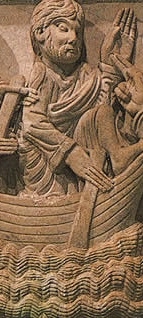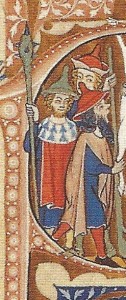Programs
 Vacillantis
Vacillantis
Social, Sensual, and Spiritual Medieval Art Songs
The development of the Latin art song (cantio, vers) during the Romanesque period is one of the most important elements of the intellectual tradition of the 12th-century renaissance. During this period clerics educated in cathedral schools and universities throughout Europe created exquisite poetry and music to express their points of view and concerns about their religious and secular society. These clerics saw themselves as moderni and hoped to create a “modern world” combining the knowledge and poetry of the pagan authors of Antiquity with a strong sense of Christian spirituality and propriety. Thus, their music represents the social and cultural movement that planted the germ of our modern intellectual and political tradition.
In the program Vacillantis Magister Petrus recreates the sound, feeling, and art of the Romanesque Latin song. The program showcases satirical, love, and dance-songs performed inside churches.
Cupid Behind the Walls
Love´s Seduction and the Medieval Cleric
One of the most recurrent subjects in the secular songs composed by medieval clerics and monks was that of human love, both platonic and carnal. The texts of these compositions reflect the how it was both desired and feared: while it was believed that love was capable of generating the most pleasant and intense emotions, it was also considered a potential danger to the intellectual mind.
In this program the group Magister Petrus presents a collection of Latin songs composed in medieval cathedral schools, universities and monasteries of the twelfth and thirteenth centuries in which both the desire and fear of secular love, as experienced by clerics and monks of the period, is recorded.
In mare vitreum 
Music in the Romanesque Ports of the Mediterranean:
Occitania, Catalonia, and Sicily
During the eleventh and twelfth centuries trade, pilgrimage and the crusades prompted European expansion throughout the Mediterranean. In this period Occitania, Catalonia and Sicily became true cultural ports of political and religious exchange. These centers also witnessed a new awareness of the sea in the religious and secular life of people: the Mediterranean and the journey to Ultramar became important referents that fed the imagination and desire of Westerners.
In the program In Mare vitreum Magister Petrus explores the notion of the Mediterranean in the compositions of the eleventh and twelfth centuries. The program combines Latin and troubadour pieces that make reference to the sea both concretely and allegorically.
Crossing the Red Sea
The Mythic Image of the Jews in the 12th-century Latin Song
During the 12th and 13th centuries the interaction between Christian and Jewish communities was marked by a contradictory relation that juxtaposed intimacy and distance. In general, the more or less harmonious coexistence of many centuries found a great disruption during this period due to increasing tension created by different voices that vilified Jews as the “enemies of the faith.” Nonetheless, at the same time the same Jews were also considered as crucial historical relics and the first witnesses of God’s covenant. These different approaches are well recorded in one of the most important intellectual vehicles of the period: the clerical song in Latin.
In Dicant nunc Hebrei, Magister Petrus explores the different perceptions and interpretations that Medieval Jews had in Christian thought as recorded in the Latin songs composed by the intellectual elite of the 12th-century Renaissance.
